
JANE BURN – POETRY AS HARD GRAFT, INSPIRATION, REACTION OR EXPERIMENT?
I interviewed poet & artist Jane Burn who won the Michael Marks Environmental Poet of the Year 2023-24 with A Thousand Miles from the Sea.
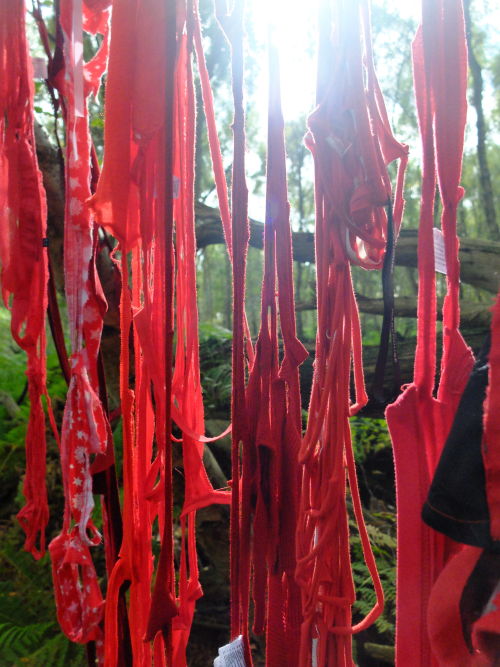
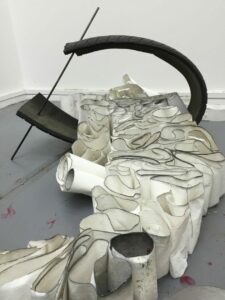
I interviewed Maria Walker whose stitched work and sculptures tell stories about working class people and the secrets of the human body. The materials she uses can range from embroidering fine silks onto linen napkins, to stitching car tyres with thick rope and copper piping. These process-led techniques, together with academic research, underpin Maria‘s large-scale, abstract sculptural work and her organic looping structures.
Leslie: What’s unusual and original about your stitched work and sculptures, please?
Maria: I’d like to think that all my work is original, as my inspiration comes from my research and how I react the world on a personal level. I have my own artistic language, which I use to create my art and this is like my handwriting. However the truth is, there will be other artists who have similar interests to me, they may have read the same books and may be doing similar things with similar materials, so perhaps nothing is entirely unique. I suppose my mixed-media sculptures and amulets are probably the most original strand of my work, in that they can’t easily be replicated, as I use one-off items that I have collected over many years.
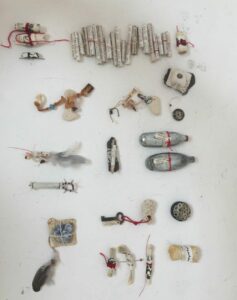
Leslie: What stories/incidents have shaped you, please? What have been the main lessons you learned from these situations?
Maria: I discovered creative embroidery when I was on maternity leave with my first daughter; I saw it on the daytime Television Programme Pebble Mill at One. I fell in love with how tactile it was and I sought out adult education classes teaching City and Guilds in Creative Embroidery.
Over the years I have had lots of setbacks. I was turned down from one group I applied to early on, as my work was “too decorative and lacked meaning”. I have been on academic courses where the tutor’s technique was to break us down in order to build us up again. What I have learnt from these situations is to have confidence in my own voice and keep on making art whatever people say. Now when I get turned down for something I have applied for I don’t take it personally, I just think that I was not what they were looking for and move on.
Leslie: Why do you call your Twitter account @blueberrybutton, please? What’s the personal significance of each of these three words on your Twitter bio: Explore Haptic Dasein?
Maria : I called my Twitter account @blueberrybutton as I set it up in 2011 at a time when I was trying to set up a business making button bracelets. I have tried to change its name as I no longer feel it is relevant to what I do artistically but I can’t change it and I don’t want to set up another account with a different name as I have quite a lot of followers. I do still love blueberries and buttons so I guess I will keep it.
My three words on my bio came about from a workshop I did with Debbie Lyddon where I had to think about my current art practice and concerns. I had to think of three words that described my art and my way of working, in a way that people might recognise me for them. I cheated a bit as I used the German word “Dasein” from the philosopher Heidegger, which means “being in the world” as I couldn’t think of a one-word equivalent in the English language.
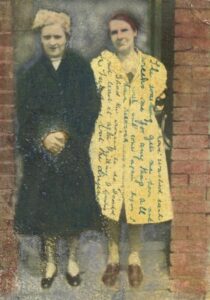
Leslie: How have you presented the stories of ordinary people in your art? What drives this interest of yours?
Maria: I have always been interested in the everyday lives of working class women as I have Northern working class roots and I saw how hard my grandmothers had to work. I carry out research to discover facts about the person or general information about the period. I started on this line of inquiry by using my own archive of family photographs as a source for my inspiration and for each photograph I wrote down things I could remember from when it was taken or stories I had been told by my parents. I find the combination of text and image a very powerful combination and if possible I prefer to use historical text, such as lines from old letters and documents.
My art is not intended to be historically accurate rather a representation of an imagined moment in time. In most cases I do not know the identity of the people who wrote the letters, so I was very surprised when I met a relative of a family who wrote a bundle of letters from the 1920’s, which I found in a second-hand shop. The lady concerned was a poet and we decided to collaborate to create an exhibition called The Lightfoot Letters. This added an extra dimension to my work I was able to discover information about this family and I was able to reunite their words with their portraits.
Leslie: What have been the challenges and successes of your installation works?
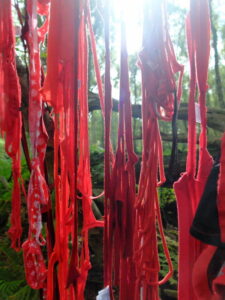
Maria: Installations are always a challenge as you have to hope that everything goes together in the location, but the most challenging installation I did was in a woodland. The walk to the installation site from my car was quite long and I had to carry ladders as well as my work. One of the trees I was hanging my work from was higher than my ladder but luckily a kind young man climbed the tree and installed to for me.
I do like installing my work large-scale textile sculptures in different locations, especially old textile mills. Memory is at the core of my abstract textile works so exhibiting in such locations introduces the concepts of time and place to my work.
Leslie: What are your individual quirks/routines/habits/rituals during the creative process, please?
Maria: My art practice is a combination of academic research and a process-led approach once I start making. My ideas are all related to the concept of ‘embodiment’ and ‘being human’. This approach was a natural progression from my earlier interest in memory and I find I make art in response to various aspects human life, such as , dreaming, brain cells, our relationship with the landscape, the fragility of our bodies and our belief in magical protection. Once I have decided on an area of interest I research the subject to provide me with a deeper insight and in order to spark ideas. At this stage I usually have ideas in my head and might do some sketches to put any ideas onto paper, and I also start making some samples to see if my ideas will work.
I am a very messy worker and jump about from project to project and sometimes I have two or three projects on the go. I use lots of materials in my art, not just textiles, so my work area gets into a mess very quickly. I find that having all my materials is an essential part of my creative process as it allows me to see unusual juxtapositions of objects and materials.
Leslie: How have you used irony, humour and ‘in your face’ effects in your art?
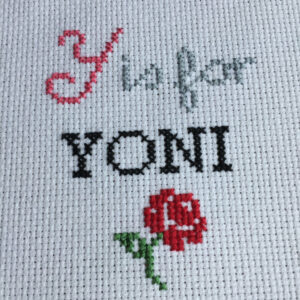
Maria: I have a weird sense of humour so I am told that this comes out in some of my work although it is not always intentional. I generally prefer the meaning of my work not to be immediately obvious to the viewer and because of the abstract nature of my art it may be open to multiple interpretations.
The most ironic and slightly subversive work which I made in 2017, was a cross stitched alphabet. It was my response to Trump’s comment, ‘Grab them by the Pussy’, women’s protest marches, pink pussy hats and the subsequent ‘Nasty Women’ exhibitions. It comprises a cross stitch square for each letter of the alphabet, and at first glance it looks like a child’s alphabet, but on further inspection you notice that each letter represents “something” relating to female sexuality. I have used euphemistic or obscure words for objects and body parts, and each letter is decorated with my hand-stitched images of everyday items, this time a visual euphemism.
Next week I interview performance poet and novelist Emma Purshouse, winner of poetry slams and the Rubery Book Award.
ABOUT LESLIE TATE’S BOOKS:

I interviewed poet & artist Jane Burn who won the Michael Marks Environmental Poet of the Year 2023-24 with A Thousand Miles from the Sea.

I interviewed ex-broadcaster and poet Polly Oliver about oral and visual poetry, her compositional methods, and learning the Welsh language. Polly says, “I absolutely love

I interviewed Jo Howell who says about herself: “I’ve been a professional photographic artist since I left Uni in 2009. I am a cyanotype specialist.


Poet Tracey Rhys, writer of Teaching a Bird to Sing and winner of the Poetry Archive’s video competition reviews Ways To Be Equally Human. Tracey,
| Cookie | Duration | Description |
|---|---|---|
| cookielawinfo-checkbox-analytics | 11 months | This cookie is set by GDPR Cookie Consent plugin. The cookie is used to store the user consent for the cookies in the category "Analytics". |
| cookielawinfo-checkbox-functional | 11 months | The cookie is set by GDPR cookie consent to record the user consent for the cookies in the category "Functional". |
| cookielawinfo-checkbox-necessary | 11 months | This cookie is set by GDPR Cookie Consent plugin. The cookies is used to store the user consent for the cookies in the category "Necessary". |
| cookielawinfo-checkbox-others | 11 months | This cookie is set by GDPR Cookie Consent plugin. The cookie is used to store the user consent for the cookies in the category "Other. |
| cookielawinfo-checkbox-performance | 11 months | This cookie is set by GDPR Cookie Consent plugin. The cookie is used to store the user consent for the cookies in the category "Performance". |
| viewed_cookie_policy | 11 months | The cookie is set by the GDPR Cookie Consent plugin and is used to store whether or not user has consented to the use of cookies. It does not store any personal data. |
4 responses
Such a fantastic guest. I’ve always loved textiles. Thanks, Leslie and good luck to Maria.
I’m so glad you’re enjoying these interviewees of mine, Olga. Thank you! Leslie
Excellent interview I particularly welcomed the honesty of Maria’s responses to the questions. Maria did not shy away from calling out negative educational practices in Higher Education, the “Closed Shop’ of certain art collectives and the managing of disappointment when work is not accepted for exhibition. I believe her open honest responses to both the positive and sometimes negative times of establishing a creative practice will be very encouraging to artist in the early stages of their creative journey.
Absolutely. Thank you, Linda.